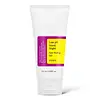What's inside
What's inside
 Key Ingredients
Key Ingredients

 Benefits
Benefits

 Concerns
Concerns

 Ingredients Side-by-side
Ingredients Side-by-side

Water
Skin ConditioningCocamidopropyl Betaine
CleansingSodium C14-16 Olefin Sulfonate
CleansingPalmitic Acid
EmollientHydroxypropyl Starch Phosphate
Glycerin
HumectantStearic Acid
CleansingVitis Vinifera Seed Oil
EmollientSodium Hydroxide
BufferingPhenoxyethanol
PreservativeCaprylyl Glycol
EmollientSodium Sulfate
C10-16 Olefin
Sodium Chloride
MaskingTocopheryl Acetate
AntioxidantLeuconostoc/Radish Root Ferment Filtrate
AntimicrobialHyaluronic Acid
HumectantHibiscus Sabdariffa Flower Extract
Skin ConditioningYeast Extract
Skin ConditioningPapain
Skin ConditioningSoy Amino Acids
Skin Conditioning1,2-Hexanediol
Skin ConditioningCarbomer
Emulsion StabilisingPotassium Sorbate
PreservativeSodium Benzoate
MaskingAlgin
MaskingWater, Cocamidopropyl Betaine, Sodium C14-16 Olefin Sulfonate, Palmitic Acid, Hydroxypropyl Starch Phosphate, Glycerin, Stearic Acid, Vitis Vinifera Seed Oil, Sodium Hydroxide, Phenoxyethanol, Caprylyl Glycol, Sodium Sulfate, C10-16 Olefin, Sodium Chloride, Tocopheryl Acetate, Leuconostoc/Radish Root Ferment Filtrate, Hyaluronic Acid, Hibiscus Sabdariffa Flower Extract, Yeast Extract, Papain, Soy Amino Acids, 1,2-Hexanediol, Carbomer, Potassium Sorbate, Sodium Benzoate, Algin
Water
Skin ConditioningBambusa Arundinacea Stem Powder
AbrasiveCellulose
AbsorbentGlycerin
HumectantRosa Damascena Flower Water
MaskingPropanediol
SolventButylene Glycol
Humectant1,2-Hexanediol
Skin ConditioningAcrylates/C10-30 Alkyl Acrylate Crosspolymer
Emulsion StabilisingHydroxyacetophenone
AntioxidantLavandula Angustifolia Flower Water
Skin ConditioningTromethamine
BufferingNiacinamide
SmoothingMaltodextrin
AbsorbentEthylhexylglycerin
Skin ConditioningDisodium EDTA
Pentylene Glycol
Skin ConditioningLactobionic Acid
BufferingPapain
Skin ConditioningHyaluronic Acid
HumectantHydrolyzed Hyaluronic Acid
HumectantLactobacillus/Soybean Ferment Extract
Skin ConditioningSodium Hyaluronate
HumectantSodium Metabisulfite
AntioxidantLactobacillus/Rice Ferment
Skin ConditioningCamellia Japonica Flower Extract
EmollientWater, Bambusa Arundinacea Stem Powder, Cellulose, Glycerin, Rosa Damascena Flower Water, Propanediol, Butylene Glycol, 1,2-Hexanediol, Acrylates/C10-30 Alkyl Acrylate Crosspolymer, Hydroxyacetophenone, Lavandula Angustifolia Flower Water, Tromethamine, Niacinamide, Maltodextrin, Ethylhexylglycerin, Disodium EDTA, Pentylene Glycol, Lactobionic Acid, Papain, Hyaluronic Acid, Hydrolyzed Hyaluronic Acid, Lactobacillus/Soybean Ferment Extract, Sodium Hyaluronate, Sodium Metabisulfite, Lactobacillus/Rice Ferment, Camellia Japonica Flower Extract
 Reviews
Reviews

Ingredients Explained
These ingredients are found in both products.
Ingredients higher up in an ingredient list are typically present in a larger amount.
1,2-Hexanediol is a synthetic liquid and another multi-functional powerhouse.
It is a:
- Humectant, drawing moisture into the skin
- Emollient, helping to soften skin
- Solvent, dispersing and stabilizing formulas
- Preservative booster, enhancing the antimicrobial activity of other preservatives
Glycerin is already naturally found in your skin. It helps moisturize and protect your skin.
A study from 2016 found glycerin to be more effective as a humectant than AHAs and hyaluronic acid.
As a humectant, it helps the skin stay hydrated by pulling moisture to your skin. The low molecular weight of glycerin allows it to pull moisture into the deeper layers of your skin.
Hydrated skin improves your skin barrier; Your skin barrier helps protect against irritants and bacteria.
Glycerin has also been found to have antimicrobial and antiviral properties. Due to these properties, glycerin is often used in wound and burn treatments.
In cosmetics, glycerin is usually derived from plants such as soybean or palm. However, it can also be sourced from animals, such as tallow or animal fat.
This ingredient is organic, colorless, odorless, and non-toxic.
Glycerin is the name for this ingredient in American English. British English uses Glycerol/Glycerine.
Learn more about GlycerinHyaluronic acid is naturally found in healthy skin. It is a humectant, meaning it draws moisture to your skin.
This ingredient helps hydrate, soothe, and protect the skin.
What makes hyaluronic acid so hydrating? It has the capacity to bind or hold large amounts of water.
Fun fact: It is already naturally found in our bodies, such as the fluids of our eyes and our joints.
Studies find this ingredient to have anti-inflammatory and anti-microbial properties. This can help speed up wound-healing.
Hyaluronic acid can be irritating if the molecule has a low-molecular weight, or if the molecules are small.
One study found low-molecular weight hyaluronic acid to be pro-inflammatory, meaning some people may experience irritation. This is because our bodies use hyaluronic acid in the wound-healing process to signal to our bodies, via irritation, that something needs healing.
The same study found high-molecular weight hyaluronic acid to be anti-inflammatory.
These are some other common types of Hyaluronic Acid:
Learn more about Hyaluronic AcidPapain is an enzyme found naturally in the papaya plant's leaves, fruit, and roots. It has antimicrobial, soothing, and wound healing properties.
Glycine and Vitamin A are naturally found in papain.
While papain is often touted as skin-lightening, further studies are needed to prove this. However, papain has been shown to help soothe acne-inflammation.
Papain belongs to a class of enzymes called proteolytic enzymes. These enzymes break down peptides and amino acids.
Some studies found papain to be a potential skin sensitizer and allergen. Those with latex allergies might also be allergic to papaya.
Learn more about PapainWater. It's the most common cosmetic ingredient of all. You'll usually see it at the top of ingredient lists, meaning that it makes up the largest part of the product.
So why is it so popular? Water most often acts as a solvent - this means that it helps dissolve other ingredients into the formulation.
You'll also recognize water as that liquid we all need to stay alive. If you see this, drink a glass of water. Stay hydrated!
Learn more about Water